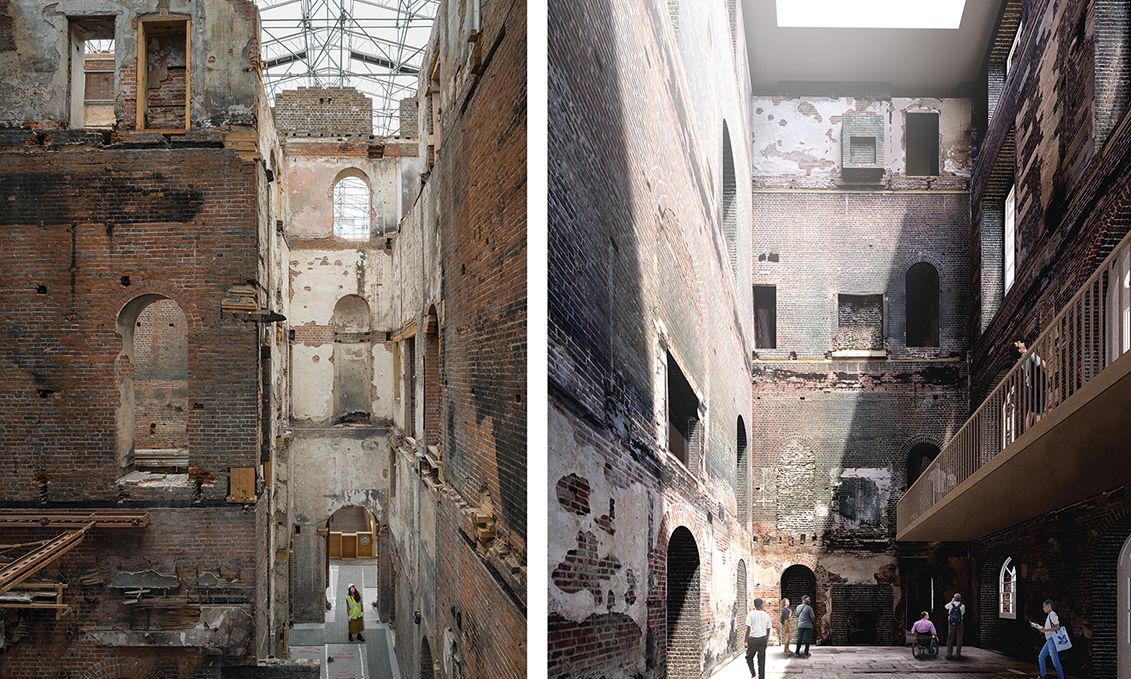Clandon Park’s brick structure (above left) survived the 2015 fire; the National Trust is working with Allies and Morrison to create an “x-ray” view of the surviving interior floors (above right)—a move opposed by Restore Trust
National Trust Images/Andrew Shaylor (left); Allies and Morrison (right)
The National Trust, a leading conservation charity in the UK, is embroiled in another controversy over its policies and future direction ahead of its key annual general meeting on 11 November. The row centres on the trust’s plans for Clandon Park, an early 18th-century Palladian mansion near Guildford in Surrey, which was gutted by fire in 2015. The campaign group Restore Trust, which is fielding five candidates for the trust’s governing council, is calling on the charity’s members to vote for an extensive restoration of the ruined building.
Under a masterplan conceived by the architects Allies and Morrison, the National Trust plans to conserve “most of the interior … in its fire-damaged state, offering people a unique ‘x-ray view’ of how country houses were made”. The trust says that “suspended walkways and platforms will give visitors new views and dramatic perspectives through the house where floors once were”. The trust will also restore the Speakers’ Parlour, including a handcrafted Baroque plaster ceiling, which largely survived the fire.
But in a statement on its website, Restore Trust has accused the National Trust of a volte-face, claiming that following the fire, a succession of senior officials stated unequivocally that not just the shell of the building but also its interiors would be faithfully restored. Outlining the plans, a National Trust spokesperson reiterates that “Clandon will be a functioning building once again: one that celebrates the architecture and collections that survived the fire”.
Crucially, Restore Trust adds: “It is stated by the trust that an insurance payout of £66m has been made as a result of the fire. It is also stated that the conservation of the shell will cost up to £20m. This leaves at least £46m for any other works. Is the trust seriously arguing that this is what is needed to conserve a collection of fire-blackened brick walls, which is what the interior now mostly consists of and if so does this really represent value for money?”
The National Trust tells The Art Newspaper that the project at Clandon is funded by the full insurance settlement and considerable additional investment. “In addition to major works to repair and conserve the structure and exterior of the house, much else is required to make Clandon a working, fully accessible building ready to open to visitors,” says a spokesperson.
This work will include the conservation of the fire-damaged interiors; the repair or replacement of all the historic windows; the creation of a new roof; the introduction of staircases and lifts; the provision of electrical and other services; and the conservation of surviving collections.
Restore Trust is also calling for the restoration of the Marble Hall, the principal room of the house, which it claims would be “entirely feasible both architecturally and technically”. But the National Trust says that the extent of damage and loss in the Marble Hall means that it cannot be restored and can only be recreated as a replica. “Sadly, none of the beautiful plasterwork ceiling survives in place and we now know that its painstakingly salvaged fragments are too fragile to be pieced back together,” says the trust’s spokesperson.
The director of Restore Trust is Zewditu Gebreyohanes, who joined the organisation in 2022 after a short stint at the influential right-wing think tank Policy Exchange. She made headlines after the former prime minister Boris Johnson appointed her as a trustee to the Victoria and Albert Museum. Gebreyohanes has a track record of opposing “woke” and “post-Black Lives Matter” policies in the cultural sector.
In an interview in The Art Newspaper last December, Gebreyohanes defined Restore Trust as “a forum where friends and supporters of the National Trust can come together to discuss their concerns about the future of the charity and lobby for change”. She said the organisation is apolitical but was critical of the “divisive ideologies” that allegedly drive the agenda of the National Trust.
Before last year’s general meeting, Restore Trust protested against the rebranding of the 17th-century residence, Sudbury Hall, in Derbyshire—another National Trust property—as the Children’s Country House, where activities such as a dressing-up salon are on offer. Restore Trust subsequently failed to secure any council seats; this year it has endorsed five candidates including the podcaster Violet Manners, the daughter of the Duke of Rutland.
The National Trust’s director of communications, Celia Richardson, has meanwhile been vocal on social media about the issues faced by the charity and how it is represented in the media. On 2 October, she referred to an article in The Guardian that day, which stated that the Conservative MP Jacob Rees-Mogg and the former Ukip leader Nigel Farage have shared “social media attack” adverts this year linked to Restore Trust’s campaign to win seats on the governing council.
“As members of the charity prepare to cast their votes in the governing council election, the National Trust spoke of its concern about the role of paid Restore Trust adverts on Facebook and their dissemination by political figures on social media,” The Guardian said. Restore Trust did not respond to a request for comment.
Richardson posted on X (formerly Twitter) that “it is one of the basics in our society that charities remain politically neutral. They must be free from political and business interests. This [Guardian] article shows Restore Trust or RT2021 Ltd, a private company, working with politicians to influence one of the UK’s leading charities.”
Richardson states on her X account that “these tweets are just mine.”

